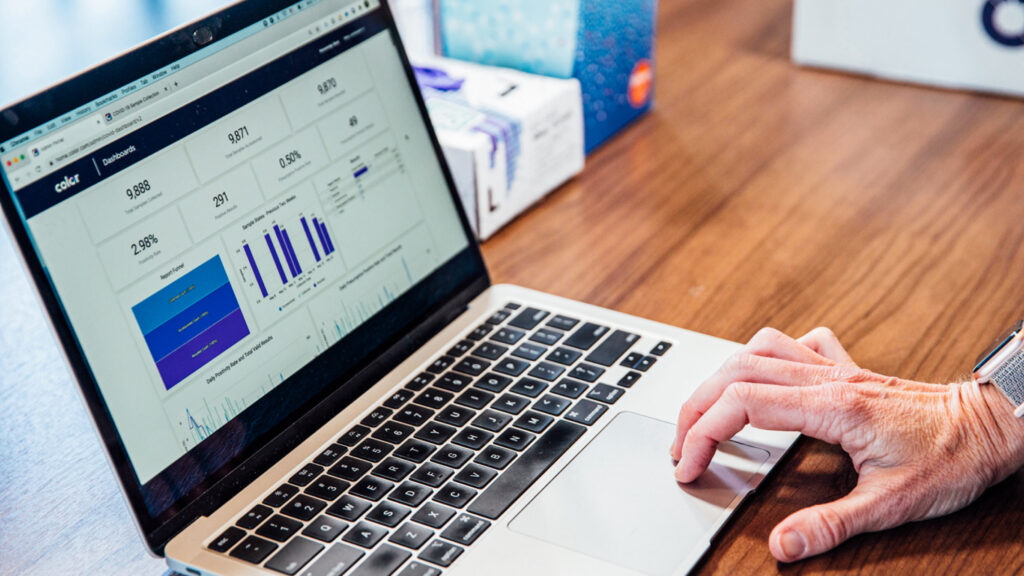News & Articles
How Our K-12 COVID-19 Modeling Tool Update Helps Schools Unmask Safely
Alicia Zhou

In mid-January 2022, we experienced the largest surge in COVID-19 cases since the start of the pandemic. As the number of cases and hospitalizations have dramatically declined in the past month, masking and distancing mandates are lifting for primary and secondary schools.1 To help school administrators and policy makers adapt their safety strategies to this new phase of the pandemic, we updated our SEIRS+ epidemiological modeling tool to account for breakthrough infections, availability of boosters, and re-infections.
This K-12 COVID-19 modeling tool demonstrates how mitigation strategies such as proactive testing, vaccine uptake, and boosters can keep schools safe even when mask mandates are lifted.
Here’s an example of how the model works:
The average adoption of boosters in the US is around 40%.2 In a primary school environment when no one was previously infected with Omicron and ~40% of teachers were boosted, masking and proactive testing was critically important to reduce the risk of a large outbreak (>5% of the school community infected).
Without infection control (e.g. masks),
R0 = 6
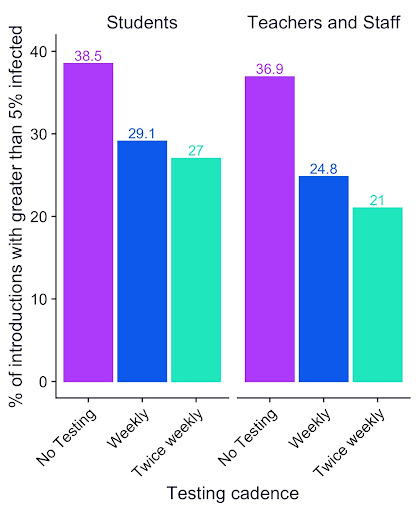
With infection control (e.g. masks)
(R0 = 4)
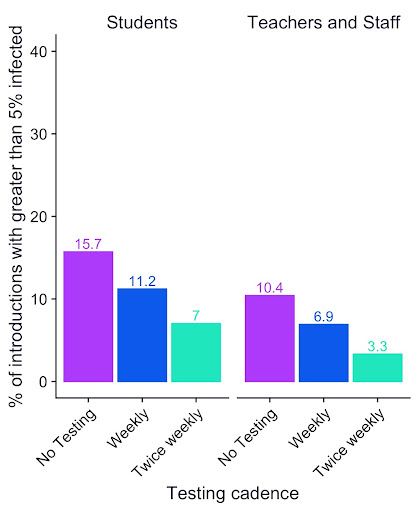
As the Omicron wave progressed, many many more people caught Omicron and got boosted. Most recent estimates are that > 73% of the US population have been infected.
Our model shows that when more people in the community have previously been infected, the risk of a large outbreak decreases, even without masks (R0 = 6).
No prior omicron exposure
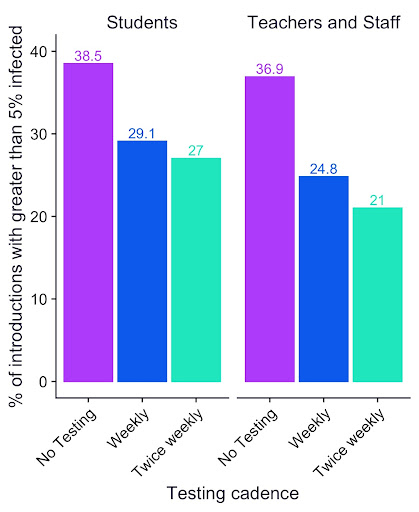
20% previously infected with Omicron
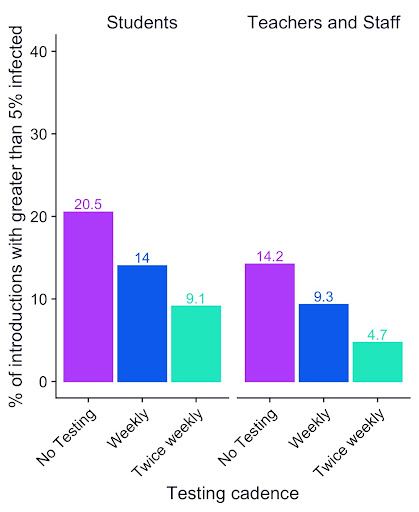
40% previously infected with Omicron
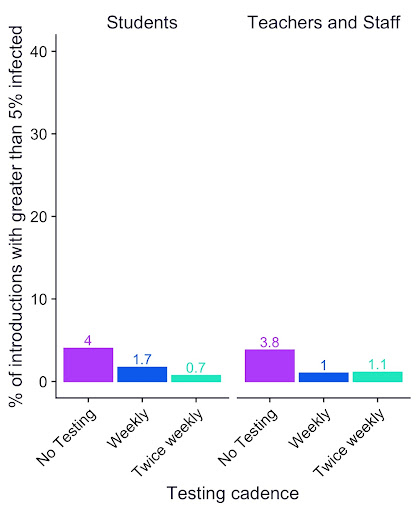
Still, weekly or biweekly testing, can help to reduce the likelihood of a school-related outbreak among both teachers, students, and staff.
What makes transmission of SARS-CoV-2 different in primary and secondary schools?
There are two key differences to consider when adapting your safety strategies for primary and secondary schools: (1) classroom organization and (2) susceptibility of children to infection.
In primary schools, students are typically assigned to a single teacher and classroom for their entire day. Whereas in secondary schools, students and teachers typically move from classroom to classroom and encounter multiple groups of students and teachers over the course of a single day. This is important because we know that having more interactions in a day increases the likelihood of transmission.
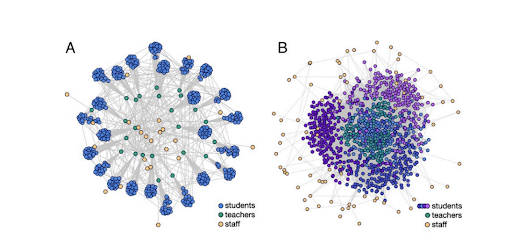
Children attending primary schools are also less likely to show symptoms of COVID-19 than older children and adults. This can make symptomatic testing in primary schools difficult. Lastly, children under the age of 12 are not eligible for boosters, which we know is an important tool for reducing infection. For these reasons, we developed two separate models for primary and secondary schools.
What factors have the greatest impact in reducing outbreaks and transmission in primary and secondary schools?
Proactive testing
Proactive testing is a useful outbreak mitigation tool in both primary and secondary schools because it identifies individuals (regardless of symptoms) who are infected with SARS-CoV-2, and ensures they are pulled out of the population before they are able to transmit to others. Both antigen testing and molecular testing (with next-day turnaround time) can be used. The most impactful strategy is to test regularly and to test everyone. The more frequently proactive testing is deployed, the more effective it is at cutting chains of transmission. Most schools should consider implementing a weekly or twice-weekly proactive testing strategy. This is particularly important when community prevalence is high and vaccine and booster adoption is low.
Vaccine and booster adoption
2-dose vaccination and booster shots for those who are eligible are effective ways to reduce COVID-19 infection. However, vaccine adoption is low for children and teens (~26% for kids ages 5-11 and ~58% for kids ages 12-17) according to the CDC. Further, less than half (48.6)% of American adults and less than one quarter (21.2%) of children ages 12-17 have received a 3rd shot (booster).2 When there is low uptake of vaccines and boosters in a community, other strategies such as proactive testing, become necessary to gauge transmission.
Non-pharmaceutical interventions (NPIs)
Non-pharmaceutical interventions (NPIs), such as masking and social distancing, can help reduce the likelihood of person-to-person transmission within schools. These safety practices are even more important when a variant of SARS-CoV-2 is highly transmissive (e.g. Omicron). Our model can help policy makers balance masking and testing strategies.
How should I use the Color K-12 COVID-19 modeling tool?
Our Omicron modeling tool for K-12 schools allows you to set the parameters for booster uptake, proportion of the community previously infected with Omicron, and non-pharmaceutical intervention (such as masking) adoption. From there, the tool shows how the impact of proactive testing can change the likelihood of a future Omicron outbreak within your community. With numerous tools at our disposal to mitigate the spread of COVID-19, schools can feel well equipped to design their strategies to keep students, teachers, and staff healthy and safe.
1 Avila Y, Harvey B, Lee JC, Shaver JW. See Mask Mandates and Guidance in Each State. The New York Times. https://www.nytimes.com/interactive/2021/us/cdc-mask-guidance-states.html. Published August 6, 2021. Accessed March 3, 2022.
2 CDC. COVID data tracker. Centers for Disease Control and Prevention. Published March 28, 2020. Accessed March 3, 2022. https://covid.cdc.gov/covid-data-tracker/

